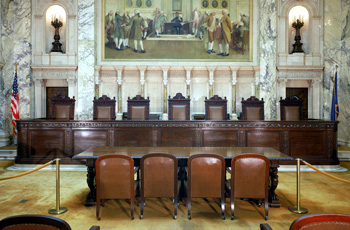Overview
 The Wisconsin Supreme Court, composed of seven justices, is the state's highest court. Located in the state capitol, the Supreme Court has appellate jurisdiction over all Wisconsin courts and has discretion to determine which cases it will review. The Supreme Court also may hear original actions—cases that have not been heard previously in another Wisconsin court. The Supreme Court selects the cases it will review based on criteria described in the Wisconsin Statutes. (external link)
The Wisconsin Supreme Court, composed of seven justices, is the state's highest court. Located in the state capitol, the Supreme Court has appellate jurisdiction over all Wisconsin courts and has discretion to determine which cases it will review. The Supreme Court also may hear original actions—cases that have not been heard previously in another Wisconsin court. The Supreme Court selects the cases it will review based on criteria described in the Wisconsin Statutes. (external link)
In addition to its law-declaring function, the Supreme Court has administrative and regulatory authority over all Wisconsin courts and the lawyers who practice law in Wisconsin.
History of the seal
 Written by Roland B. Day, Chief Justice (retired), Wisconsin Supreme Court
Written by Roland B. Day, Chief Justice (retired), Wisconsin Supreme Court
The seal of the Supreme Court of Wisconsin is rich in symbolism. It shows a scale of justice, not held by the blind-folded Greek Goddess Themis, but by a human hand and arm. Thus, it recognizes that justice is in human hands.
Above the scale is the ancient symbol of the all-seeing eye of deity.
The seal was created sometime after August 12, 1848, when a joint resolution of the legislature provided that Edward H. Rudd be employed to engrave "a great seal for the state of Wisconsin and seals for the circuit courts and judges of probate of the several counties and supreme court of the state."
The resolution instructed Rudd to follow an existing pattern for seals currently in use, replacing the word "territory" with "state".
Seven months later, Governor Nelson Dewey signed into law a bill which authorized the secretary of state to "employ a competent and skillful engraver to engrave a seal for the supreme court, and the great seal of the state…"
The new law, Chapter 202, further authorized the secretary of state "to procure a good and substantial seal press for the use of the state and the supreme court," and provides that the costs will be paid out of the state treasury.

